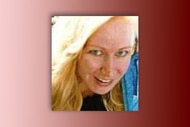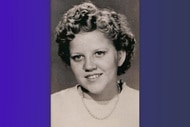Create a free profile to get unlimited access to exclusive videos, breaking news, sweepstakes, and more!
Missing California Mom ID’d As Woman Found Buried In Makeshift Grave In 1994
Nearly three decades ago, scrap metal collectors in the California desert found a makeshift grave containing the partially nude body of an older woman who has only now been identified.

The remains of a murdered California woman, found buried in a shallow grave in the Coachella Valley desert nearly 30 years ago, have finally been identified with the help of DNA evidence.
Her name was Patricia Joan Cavallaro.
On Oct. 24, 1994, scrap metal collectors near Thousand Palms, California, stumbled upon a makeshift desert grave containing a partially nude body, the Riverside County District Attorney explained. The older woman was wrapped in a white plastic sheet, and investigators estimated she’d been dead for approximately three weeks.
Her death was subsequently ruled a homicide by the Riverside County Coroner’s Office, even though her autopsy results proved inconclusive. At the time, DNA from the woman’s decomposing remains yielded no evidentiary leads as to her possible identity.
“They came out and processed the scene, and gathered whatever they could possibly get, which was really not much,” Ryan Bodmer, Regional Cold Case Homicide Team supervisor for the Riverside County District Attorney's Office, told Oxygen.com on Tuesday.
Officials publicly released a composite sketch of the mystery woman in the 1990's, which also proved unsuccessful. The case ultimately went cold.
Decades passed before detectives caught a break. In 2021, cold case homicide investigators sent a bone sample from the remains to Texas-based private DNA lab, Othram Inc., where a DNA profile was developed The enhanced DNA profile was later uploaded and cross-referenced across publicly available genealogical sites, such as GEDMatch. Further forensic genealogical research ultimately pinpointed someone as a possible relative of the murdered California woman.
“We extracted DNA from the skeletal remains and then used Forensic-Grade Genome Sequencing to produce a comprehensive DNA profile,” Dr. David Mittelman, the CEO and founder of Othram Inc. told Oxygen.com in an emailed statement. “We returned this profile to the agency. The agency did their own family tree research and determined that there was a likely biological child for the unidentified woman.”
Investigators interviewed the man and discovered he’d been estranged from both his parents for years; his mother, Patricia Cavallaro, would have been 57 at the time of her death.
Now in his late 50s, the man was stunned to learn his mother had been murdered. He told law enforcement his mother and father had been living together in Downey, California at the time of her disappearance. His father, he said, died in 2017.
“He hadn’t had any contact with his mother since leaving the home as a 20-year-old kid so there wasn’t a whole lot of contact with mom,” Bodmer added. “He did know that his mom was not around — never really have an answer to that but had always assumed, given her advanced age, and his father has already passed away, as well, that she was more than likely deceased. He just didn’t have any idea how.”
Despite Cavallaro’s death in 1994, the California mother wasn’t reported missing for almost another decade. Years later, fraud investigators noticed social security checks in her name were still being cashed — but suspected another individual was signing them, according to a 2001 Los Angeles County Sheriff's Department missing person's report obtained by Oxygen.com.
At the time, her daughter, Victoria Cavallaro, told detectives "her mom just walked away in 1994."
The slain woman’s late husband, Samuel Cavallaro also "refused to give any information" when contacted by law enforcement. Neighbors, however, told authorities the couple frequently argued. Officials now say Samuel Cavallaro is now a primary suspect in the unsolved killing.
“He would have been a huge person of interest,” Bodmer stated. “We don’t know entirely. We just know at the time of her disappearance she was, in fact, living with her husband, who is deceased.”
County officials are now working with Cavallaro’s family to ensure the California mother receives a proper burial. Her surviving son has asked to remain anonymous.
“It’s a win for us to put a name to a face — a big win,” Bodmer said. “It means everything. It’s putting a name to a person that didn’t previously have a name for almost 30 years. Ultimately, to bring closure not only for the victim, but for the victim’s surviving family.”
The investigation into Cavallaro’s murder is open and ongoing. Detectives are now seeking information from the public regarding anyone who may have known or had possible contact with the Cavallaro family in the mid-90's.
“We have to look through everything,” Bodmer said. “There could be an additional person that comes forward that may have had some information, that may have had a conversation with somebody that we don’t know about, and that conversation could lead us to somebody that may have been an accomplice or an accessory.”
Patricia and Samuel Cavallaro had moved to California from New York State in the mid-late sixties, according to the Riverside District Attorney’s Office. The couple, who had two children together, don’t have any other known extended family in the state. If alive today, Patricia Cavallaro would have been 84.
Authorities are also actively searching for the Cavallaros' daughter, Victoria, who they suspect may be homeless — and could provide further clues as to her mother’s disappearance.
“I would love to find her,” Bodmer said. “We’ve looked everywhere for her. We had flyers up to try and find her, as well.”
Anyone with additional information related to Cavallaro’s disappearance or death is urged to contact the Riverside County District Attorney’s Regional Cold Case Homicide Team at 951-955-5400.
Without advances in forensic genealogy and DNA sequencing, authorities said Cavallaro may have never been identified. Riverside County cold case investigators are now applying similar forensic techniques to a number of unsolved killings.
“We have a lot of these types of cases that are lined up right now, that are in the various stages of testing, from ‘75 to ‘82, to most of our earmarked cases are right around 1995 onward, just because of solvability factors,” Bodmer explained.
Othram Inc., the DNA lab whose patented Forensic-Grade Genome Sequencing technology assisted investigators in identifying Cavallaro, has solved numerous other cold case murders in recent years.
“We are on a mission to help all families that have been victimized by crime,” Dr. Kristen Mittelman, the company’s Chief Business Development Officer, also told Oxygen.com. “Our Forensic-Grade Genome Sequencing technology is all-inclusive of the diverse and challenging forensic inputs that are found at crime scenes. This is a key prerequisite to helping all, and not just some, unsolved cases.”



























